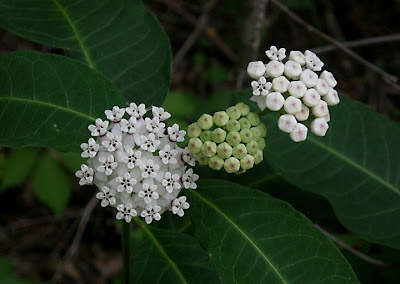 Plants at the edge of the woods in Fort Yargo State Park in Barrow County, Georgia.
Plants at the edge of the woods in Fort Yargo State Park in Barrow County, Georgia. A closer view. The leaves are broad but have a pointed tip unlike the leaves of the Clasping Milkweed which have blunt ends
A closer view. The leaves are broad but have a pointed tip unlike the leaves of the Clasping Milkweed which have blunt ends Several views of the multiple umbels that are common on Redring Milkweed plants. The flowers are in tight clusters
Several views of the multiple umbels that are common on Redring Milkweed plants. The flowers are in tight clusters This photo shows the red ring that gives this species one of its common names.
This photo shows the red ring that gives this species one of its common names. A closer view of an individual umbel. You can just spy some legs of a crab spider at the top of the umbel in this photo.
A closer view of an individual umbel. You can just spy some legs of a crab spider at the top of the umbel in this photo. I saw several crab spiders, including this male spider, on the plants in Fort Yargo State Park.
I saw several crab spiders, including this male spider, on the plants in Fort Yargo State Park. Close view of the flowers. The hoods of Amplexicaulis variegata are shaped quite differently from those of Asclepias amplexicaulis. The hooks of A. variegata are closed tightly over the stigmatic disk comparison with those of A. amplexicaulis that are ‘loose.’
Close view of the flowers. The hoods of Amplexicaulis variegata are shaped quite differently from those of Asclepias amplexicaulis. The hooks of A. variegata are closed tightly over the stigmatic disk comparison with those of A. amplexicaulis that are ‘loose.’ The hoods of the Asclepias variegata almost touch, compared with those of Axclepias amplexicaulis.
The hoods of the Asclepias variegata almost touch, compared with those of Axclepias amplexicaulis.Asclepias flowers appear ‘clean’ because they don’t have loose pollen grains that dust the flowers. Asclepias flowers are unusual; diagrams of the anatomy of the flowers may be found here. The pollen is contained in sacs called pollinia that are located between the anthers. Two pollinia are connected by a ‘thread’ called a translator to a body called a corpusculum. Pollination only occurs if an insect is strong enough to hook the corpusculum and pull the pollinia from their sacs and deposit them on the stigmatic disk of another flower. You can see a photograph of the pollinia of Axclepias amplexicaulis here.
Asclepias variegata (Redring or White Milkweed) is native to the United States. It is found in states east of a line from Illinois, Missouri, Oklahoma and Texas; it’s not found in the New England states. It is found in Ontario, Canada. In Georgia, plants may be found more frequently in the Piedmont counties than in coastal plain counties.
Click on an image to view a larger image
Distribution:
- United States Department of Agriculture Plants Database: Asclepias variegata (Redring Milkweed)
Identification resources:
- Southeastern Flora: White Milkweed (Asclepias variegata)
- Missouri Plants: Asclepias variegata
- Natural and Naturalized Plants of the Carolinas and Georgia: Asclepias variegata (White Milkweed)
- Wayne’s World: Botany 110. Flower Terminology Part 1, 4. The Remarkable Bisexual Milkweed Blossom
Related posts:
- 2010: Year Of The Wildflower – Wildflower Index
- Clasping Milkweed (Asclepias amplexicaulis): Flowers
- Green Comet Milkweed (Asclepias viridiflora)




No comments:
Post a Comment